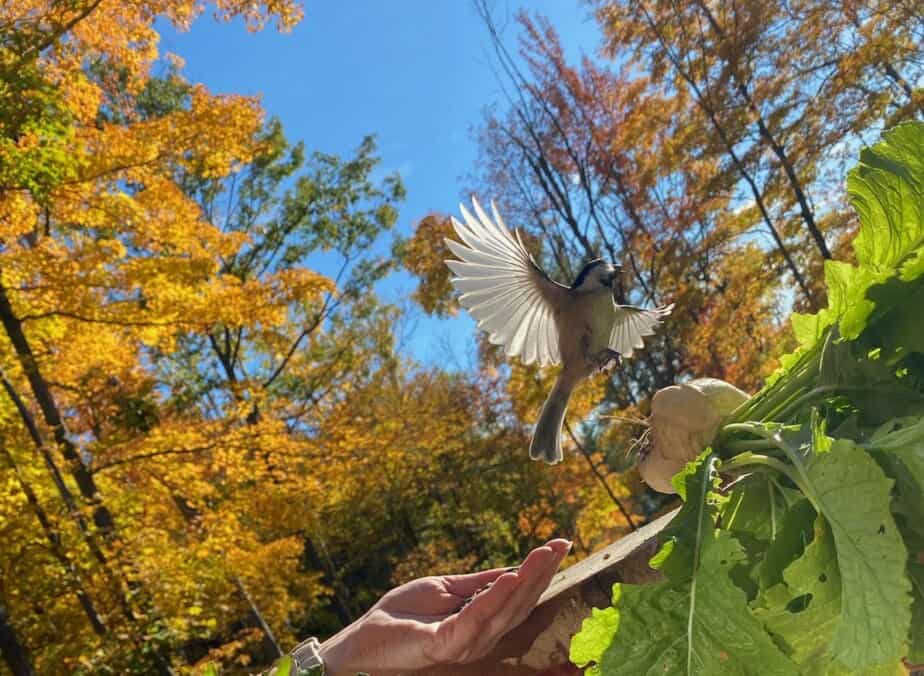This post may contain affiliate links. If you use these links to buy something we may earn a commission. Thanks.
Forest gardens are permanent edible plantings with layers of trees, shrubs, herbs, and vines that mimic the functionality of a forest. Since forests can harness the energy from the sun, they are able to sustain and grow life.
I’ve listed 9 benefits and then explain how effective food forests are in regard to world problems.
They offer nutrient-dense food for everyone
Humans and animals can enjoy a wider variety than we know of fruits, nuts, mushrooms, and greens.
Since permaculture forest gardens are permanent plantings, functional establishments can form. What does this have to do with nutrient-dense food? Well . . . Mycelium networks rely on permanence to grow into vast systems that transfer resources like water, carbon, nitrogen, and minerals. Fascinatingly, Mycorrhizal fungi unite Individual plants into networking communities. They network and trade nutrients as we do with goods and services.
Since annual vegetables are shallow and surface level; they do not get the opportunity to establish relationships that render overall growth and self-sustainability. Therefore, nutrient-dense food is hard to accomplish using this system.
They protect the soil with consistent coverage
Each year the trees and shrubs of a forest garden drop their leaves and the growth of herbaceous perennials dies back. Over the course of the winter, spring, and summer the material from last autumn is converted into soil. Every year the leaf litter falls to restock the soil—just like uncultivated forests!
Coverage for soil is like a shelter for us. It prevents energy and resource losses and maintains a livable environment. Without shelter the topsoil would bake in the sun, the wind would blow it away, the rain would cut a path, and the life would either move down to the moisture or die. Soil coverage provides shade, preserves moisture, and maintains stability.

They regenerate soil nutrients
Conventional farming for vegetables has evolved to rely on synthetic nutrients to feed plants. Why? Because if we remove diversity from the process of growing food; we become responsible for replacing it.
If we harvest a complete plant; we create a need for replacement.
Replenishing soil nutrients or replacing plants aren’t manually required In a forest garden. A food forest is designed in a way that not all components are for the taking, but multiple for giving back to the system.
In a food forest; diversity and contribution are integrated, plants are not completely harvested, and perennials live to produce for many years.
They are an asset worth creating
A forest garden is a delayed gratification investment. The initial work to plant a perennial food forest is the most effort you’ll require to reap decades of nutritious fruit.
There will be grocery bills saved and surplus food to sell.
How Much Will it Cost You to Start Your Food Forest?
They are low maintenance
After the initial setup, the maintenance required will decrease each year. As they establish and out-grow competition, your forest garden may eventually become self-sufficient. Self-sufficient systems are created with mutually beneficial relationships.
Related post: How To Find and Pick the Best Plants for Any Forest Garden
Once a productive system is self-sufficient, food is literally free!
They sequester and store carbon
Organic matter in soil comes from carbon! Carbon is essential for fertility, water retention, and a breathable soil structure. A forest garden not only replenishes the soil with carbon material every autumn, but also when we chop and drop, coppice, pollard, or prune our trees and shrubs.
Growing plants and using their material to build soil creates sustenance for life in general—thank you, Sun!
Include vigorous growing plants strictly for the purpose of chopping them down. They will be large contributors to a self-sufficient forest garden. One of our favorite carbon capture plants in zone 5 Ontario, Canada are sumacs!

They look tropical, grow fast, have edible qualities, and have striking colors in fall.
They conserve and create drinkable water
Forest gardens and their foliage slow down the flow of water. When a forest receives rain, the trees drink only what they need and allow the rest to refill groundwater aquifers. A process that filters drinkable well water!
They make use of water and prevent flooding
Since the ground is also kept covered; it is kept moist. Moist surfaces chemically attract new water. The ground is like a moist sponge, and it swells when it rains.
Unprotected bone-dry soils are like dry sponges; they repel fast-moving water. Consequently, water will stream on top of the surface level and cut its way down to the lowest point of the landscape. Floods and erosion occur when trees are removed. As a result, water that could have been fresh is now dirty and undrinkable.
The more forests and food forest gardens we have, the more hospitable and abundant our environment becomes.
They provide shade and shelter
Permanently planted areas absorb and make use of the sun’s energy. Using our limitless ball of fire way out there, they continue to grow bigger and bigger.
As a result, we can stand under their shade, thin them down to harvest some wood, build a house, and watch the rest continue to grow. All we need to do is replant trees and preserve their space.

When we fail to preserve a forest’s space, we end up with city-scapes and mono-crop vegetable production.
City-scapes are made of material that retains the heat of the sun and doesn’t grow into shade-providing structures. They don’t grow because they aren’t alive to use the energy, only store it. They simply retain and release heat.
Vegetable gardens aren’t permanent plantings that continue to grow bigger. They grow over a single season, we harvest them completely and leave unprotected soil behind. The sun’s energy got used for our consumption, but nothing is left to anyone (the soil) to provide shelter or shade. Vegetable gardens serve less purpose and strip life out of our limited topsoil supply.
Forest gardens are multi-purpose life-supporting systems.
How effective are food forests?
More of us are becoming curious about the effectiveness of food forests as the concept piques our curiosity. Since starting our own food forest, we have realized just how effective they are!
Food forests are highly effective at solving several resource management problems because they can become practically self-sufficient. They can make a sustainable food system, low maintenance community gardens, and help keep the earth in habitable condition.
They can sustain a practical food system
Food forests are a solution to the true cost of food.
The food at the store may seem expensive to those who do not grow food themselves. In reality, the food offered at stores is extremely cheap! Their poor quality also reflects how truly cheap they are. Cheap is not a good thing. Cheap doesn’t really exist. Cheap translates to unsustainable.
Vegetable crops are highly expensive to produce on both human and machine scales. The cost is not a matter of money. The cost is a matter of time and life-giving resources. If we deplete vital resources, we will be left with nothing to live from.
Our lives depend on self-sufficient systems. One example of a self-sufficient system is a forest! Since food forests mimic these systems, they are the solution to the unsustainable food crisis.
They make community gardens easy to maintain
A community forest garden will always be easier to maintain than a traditional vegetable community garden. The fundamental reason is because of the extended community!
Related post: How To Start a Community Food Forest Garden: Complete Guide
Food forests rely on communities beyond humans to function independently. They invite the wild in to work together. It might appear that wildlife only takes away from your harvest, but the way they live is to give.
For example, birds might take some of your berries, but they also manage the crawling pests and drop valuable manure. Now, you don’t need to manage the pests yourself, you don’t need to add fertilizer, and you still get plenty of fruit!

For another example, trees might drink plenty of water but they drop their leaves, give us shade, use the sun, and provide us with medicine. Once established, they manage their own water by protecting the soil and we have food and medicine in return for barely lifting a finger in the grand scheme of their contribution.
In a community vegetable garden, all these inputs are taken from our time and energy, which we can’t seem to sustain. We don’t physically harness limitless energy from the sun as trees do!
If you must have a vegetable garden, (as we do!) I wrote about everything to include in a sustainable community garden.
They contribute to a habitable earth
The issue with our current unsustainable food system hinges on exclusion. Not only do we waste our time attempting to grow things ourselves for maximum yields; we take away jobs from the wild.
Taking jobs/positions/roles away from the wild hinders their ability to live. It means their access to life-giving resources has been taken away.
When we remove them from our food systems, we are taking over a place they once resided and misplacing them.
Our habit of exclusion first started in the wild, and today it’s happening to humans with robots!
When will we all come together to include everyone again? How can we do it?
We can all start with planting a forest garden because including all forms of community is our only way to thrive.
This article was originally published on foodforestliving.com. If it is now published on any other site, it was done without permission from the copyright owner.
Recent Posts
There’s no shortage of full-sun ground covers for zone 4 climates! Each plant in this list can withstand the frigid temperatures and also enjoy the hot sun in summer. Full sun means that a plant...
There's no shortage of full sun ground covers, not even in zone 3! Zone 3 climates offer hot but short-lived summers and very cold winters. So each plant in this list can withstand the frigid...
